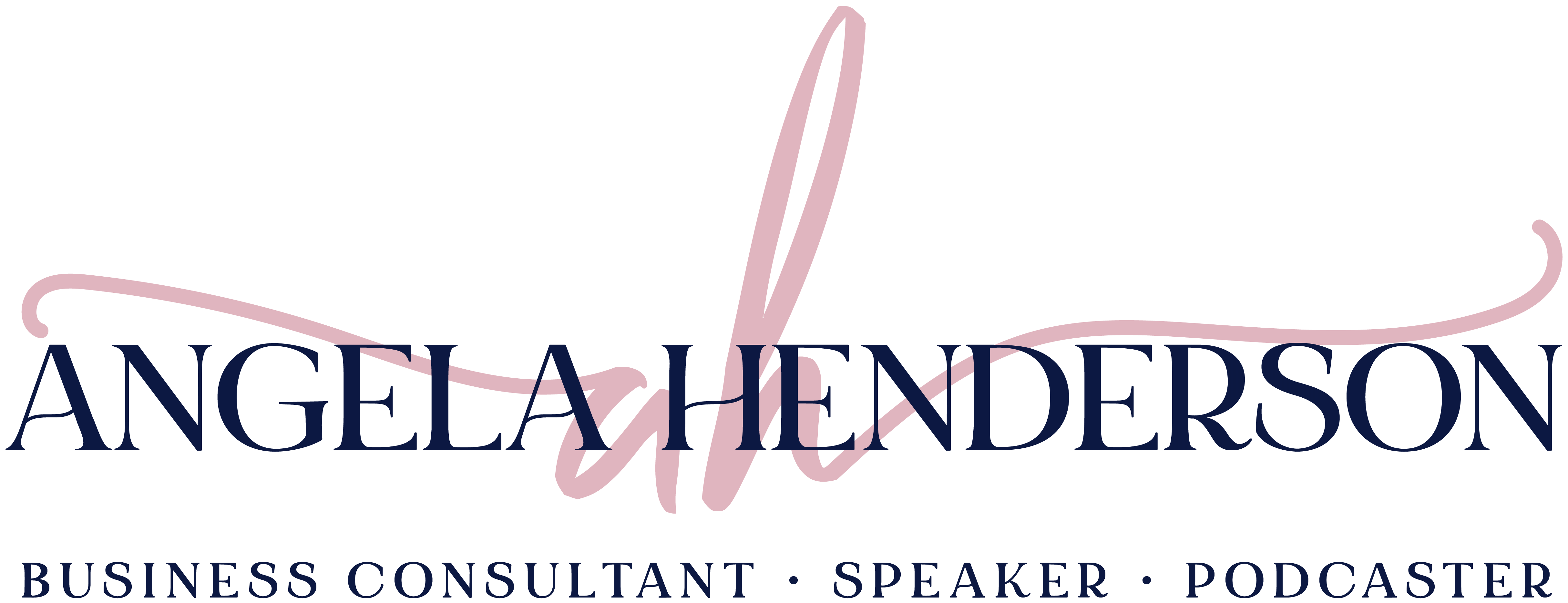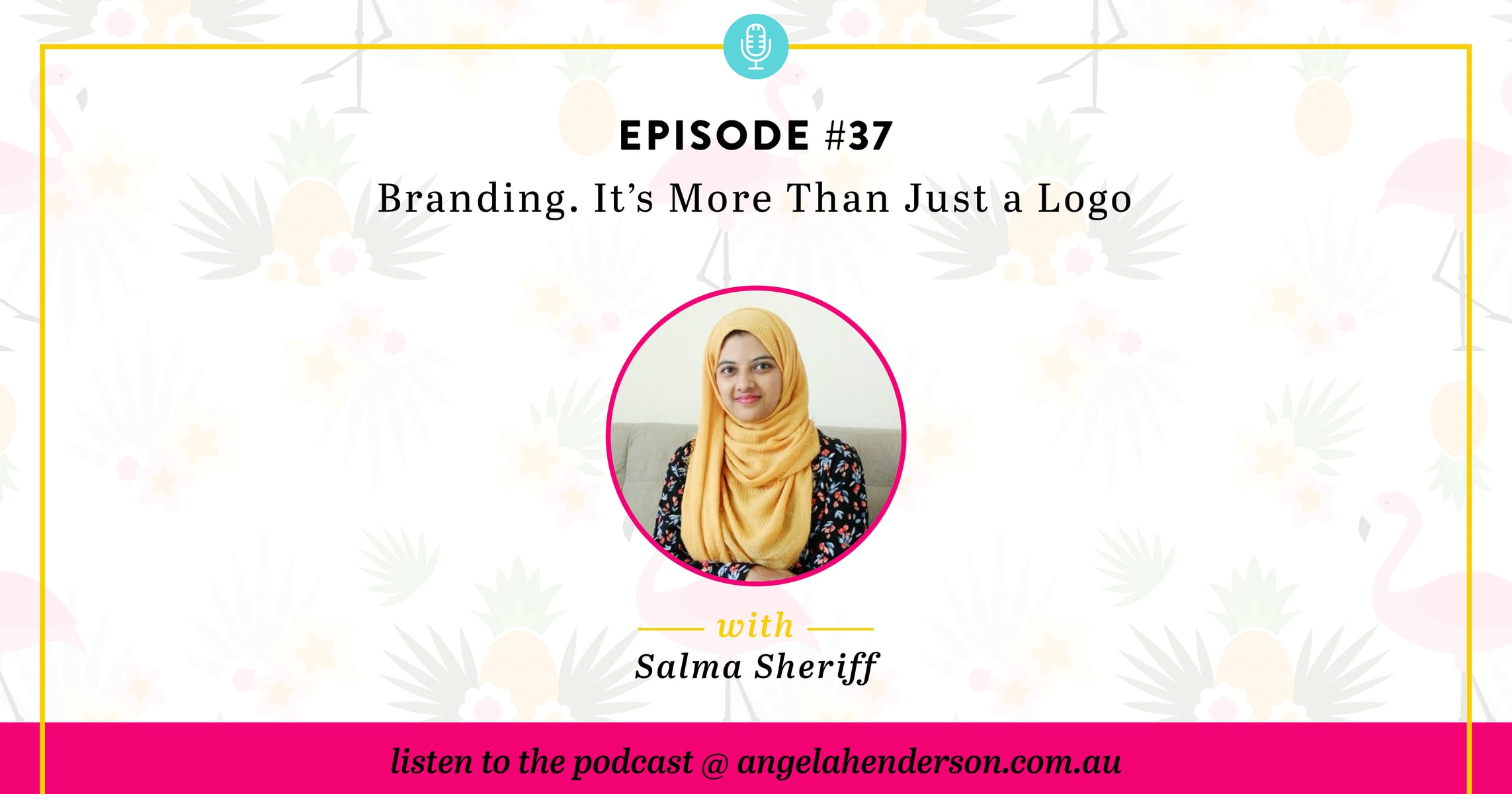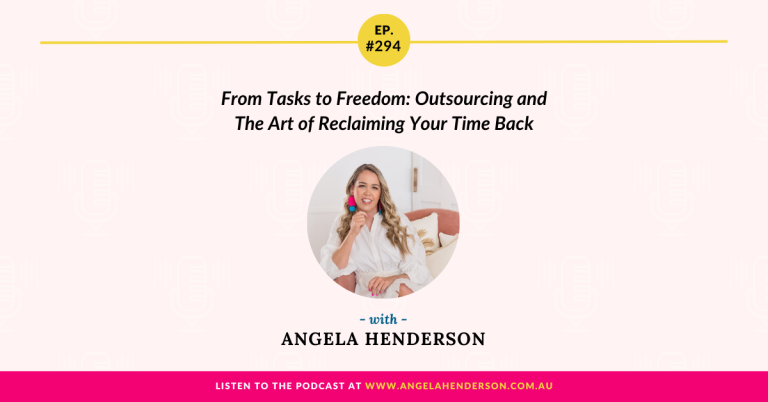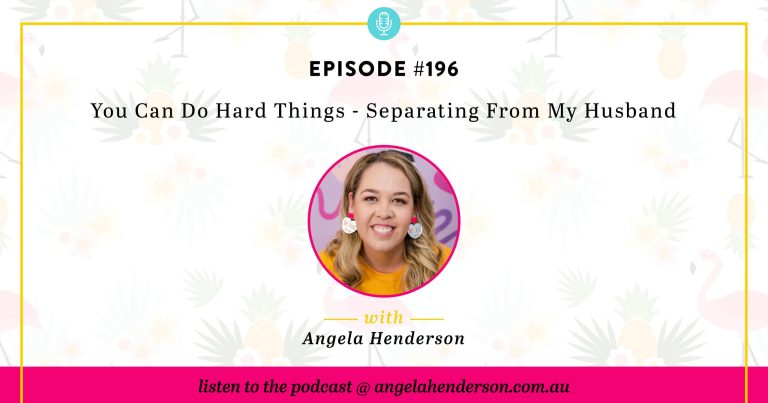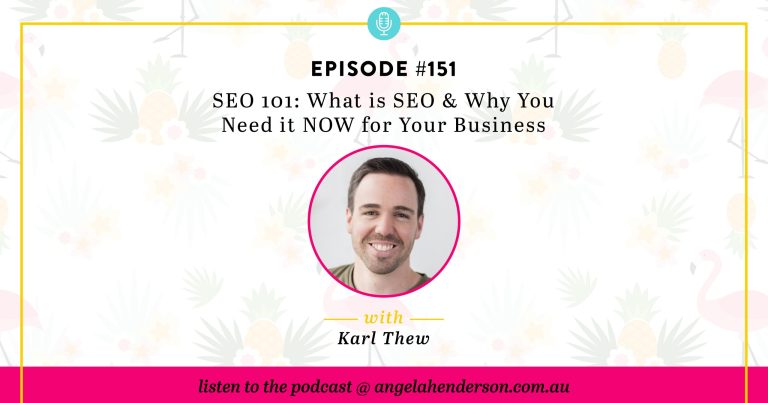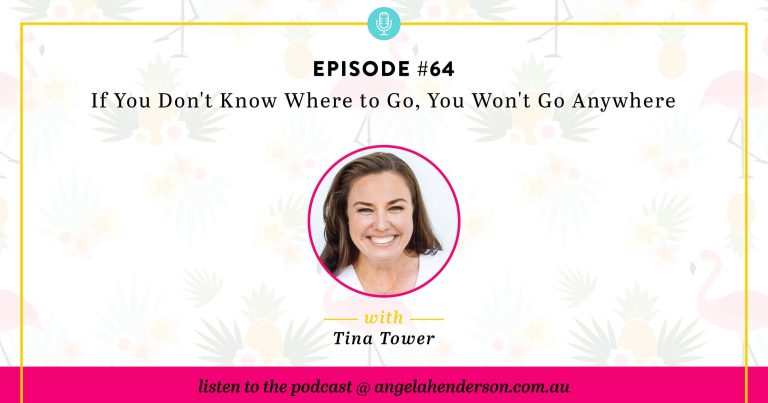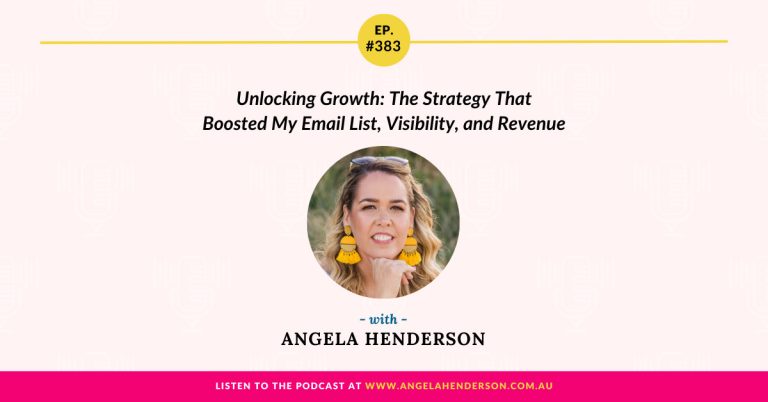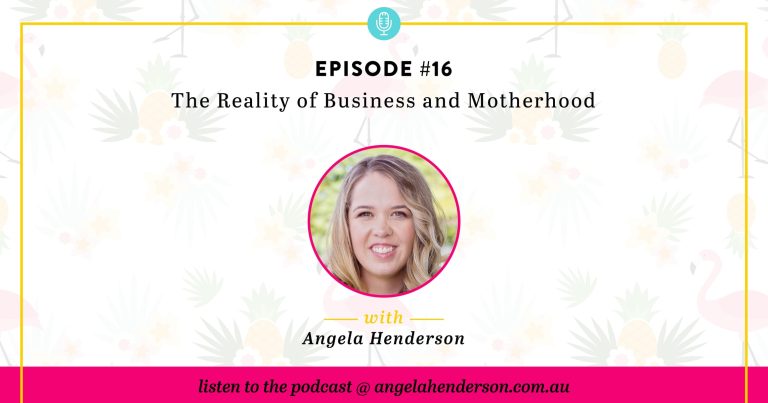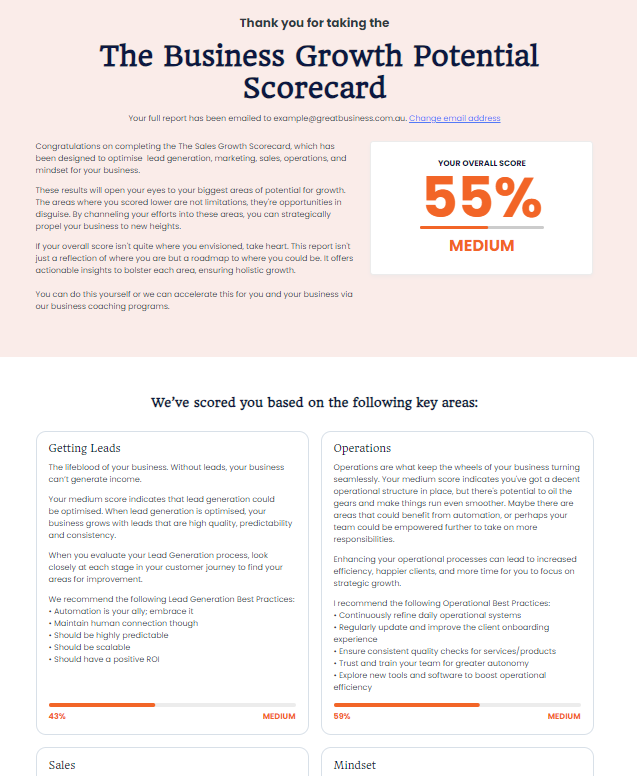Branding your business is so much more than choosing your name or designing your logo. In Episode 37 of the Business & Life Conversations Podcast, Salma Sheriff joins us to explain why “Brand is everything and everything is brand.” She explains why branding matters for the success or detriment of your business and how emotions play a role in your brand. She also breaks down the 3 main components to a brand that businesses should focus on. Listen in and take action today.
Important Links Mentioned in the Show:
Salma Sheriff Designs Facebook
Salma Sheriff Designs Instagram
Angela Henderson Active Business Facebook Group
Angela Henderson Facebook Business Page
Prefer to read Branding. It’s More Than Just a Logo? Here’s the transcript:
ANGELA:
You’re listening to the Business and Life Conversations podcast, with Angela Henderson, episode 37.
Hey there, you’re listening to the Business and Life Conversations podcast, my name is Angela Henderson, and on this show we talk about improving your business, life or both. By having amazing and rich conversations with brilliant guests. Who will inspire you and who will give you tips and tricks, to help you grow both in life and in business.
Hey there everyone, this is Ange from Angela Henderson Consulting and welcome back to another episode of business and life conversations podcast and as always thank you so much for being here. Today I am super pumped to have the amazing Salma on the show today because she’s not only as one of the most amazing designers I’ve worked with, but I’m glad to call her a friend.
In this podcast, Salma and I are gonna be talking to you about branding. What are the main components to a brand that businesses should focus on? Why does branding matter? But ultimately at the end of this podcast, I really want you to be able to see that branding is so much more than a name or a logo.
In fact, brand is everything and everything is brand. But before we get into all levels of branding, I just want to take a moment and let you know that this episode is sponsored by Profit Pillars, which is my ready to implement eight-week program designed for women in business, to get your business the bulletproof advantage it needs to protect itself from the overwhelm, frustration, and heartbreaking failure.
With the step by step approach and built in accountability and implementation, this is the only business growth program that shows you how to put passions and purpose together and generate profits for your business. All you need to do is go to www.angelahenderson.com.au and search Profit Pillars to join the wait list as the next enrolment will be starting soon. Let’s not wait any longer and let’s get started on talking about all things branding with Salma. Welcome to the show, Salma.
SALMA:
Hey Angela, thank you so much for having me.
ANGELA:
Yes. How are you now? What time is it? You’re over in India, so what time is it over there?
SALMA:
It’s 8:40am right now.
ANGELA:
I’ve got you up early for this one. So it’s 8:40am. We’ve got about 1:10pm here in Brisbane, so thank you so much for being so lively and prompt and giving me an 8:00am call.
SALMA:
I’m really excited to be here on the show.
ANGELA:
Listen, as I do with every guest on the show, I’d love you to talk to us a little bit more about who you are, your business etcetera. Because I think it’s really important for listeners to have a better understanding before we jump into the world of branding of who you are and also, I would love for you to share with us your favourite thing about living in India.
SALMA:
Absolutely. So, the reason why I started my business as a brand and web designer is like I moved on from being a product-based business owner, so I was selling crochet products, and like three years into that is when I realised that I needed to do something more with the education and the passion that I had.
So my education was Master of Engineering in Computer Science and I was really interested into design and helping other women entrepreneurs. And that’s when I realised, you know, I need, I had to merge my passion and my education in order to deliver something good so that I’m not just able to help myself, but I’m also able to help other women entrepreneurs as well. And that’s when I started my own brand strategy and web design studio. So, I’m currently helping women entrepreneurs around the globe to build brands and also high converting websites as well.
And one thing that I love about India is the food. I absolutely love it and no matter where I go, I definitely think of the food that is here and especially my mum’s handmade biryani, that I have to mention because it’s very famous here and when I was studying in school or in college, you know, all my friends used to ask me, “You know Salma, when you go home please bring back your mum’s biryani”.
ANGELA:
Bring back the goods.
SALMA:
Absolutely. She’s the best. And you know, you wouldn’t believe Angela, my father also owns a bakery, so I love everything in that as well.
ANGELA:
So basically, what you’re saying if I need to come to India because, so from, there’s another guest and I’d have to double check what podcast it was on, but it was all about launching your courses and what you need to do. And that was with Perona, another wonderful friend of mine from India. So now how far away are you and Perona?
SALMA:
I think we are.. I think she’s in the northern part of India and I’m in the southern part. So, if you’re travelling by a flight it will just take an hour or two. So, I’d love to have you here in India.
ANGELA:
So, what you’re saying is I need to come to India because from what I also understand about the Indian food is that, each region of India produces quite a vast different taste of food.
SALMA:
Yes.
ANGELA:
But people make an assumption that “Oh, it’s India, all the food is the same”. But from what I understand, correct me if I’m wrong, but a butter chicken in northern India can be slightly different than a butter chicken in southern India. Is that somewhat right?
SALMA:
Yes. And also when I say the word biryani, even that, you know, the texture, the flavour changes from north to the south as well. And here the very, the famous dishes here in south India are akili, dosa, sambar, it’s like, kind of like a rice, you know like a party kind of thing. It’s very, very tasty and I just love it. Okay. I’ve now started to feel hungry.
ANGELA:
I know we’re talking about food, but I think I always talk about food with the majority of my guests, and then I’ve got to remember we’re here to talk about business too. So, we’ll bring it back to branding. Now as a business consultant, I don’t know how many times endlessly I hear either in my one to one consulting sessions in my Facebook group, the Australian Business Collaborative or other Facebook groups, networking events, I always hear this, something along the lines. “I keep hearing a lot about branding, but I’m not even sure what it means or where to start and I’m just like, oh my goodness, how are we here?” You know, but with so many moving components of a business, it makes simple sense. Not everyone understands the true definition of branding. So, I think it’s really important that we lay down what branding is and how it can be used for my service, your service, all those listeners out there, businesses.
And before we get into your thoughts, one of the things that I wanted to summarise was, I was reading an article about branding likely by a guy of the name of Dan Pallotta, and I really thought he summarised what is branding quite beautifully. He says, “Brand is strategy, brand is your calls to action, brand is your customer service, brand is the way you speak, brand is an array of communication tools, brand is your people, brand is your facilities, brand is also your logo and visuals, but your logo is not just your brand”.
So ultimately brand is about caring about your business at every level, in every detail from the big things like mission and vision to your people, your customers, and every interaction anyone is ever going to have with a particular business such as yours. So for yourself, you know, obviously this is quite intense that some listeners out there might go, “I didn’t think about branding a strategy or cost action or about it being your people”. Do you agree that brand is much more than just a logo, Salma?
SALMA:
Absolutely yes. One misconception that everyone, they have about branding is, it’s just your logo or the colour that you see either on your website or on your marketing materials, or the font that you choose or the mood board or the colour pallet. So I would say that this particular visual of the element is just one component of your overall brand.
And as you have just said, you know, you quoted, a good branding is actually something, it is a symphony of both the design, the language and the expedience. So, all of this combines and comprises what the branding is about. So it is a set of perception people have about your service or your company. And it is also carefully curated expression that lives in people’s hearts and minds when they think of your brand.
It’s also a set of actions that you take in order for your services to reach out to the audience. And it also includes the visual elements as well. So all of this, so not just the visual or the identity comprises of a brand, the brand strategy, your target audience, the way you put forth your message, everything that goes in and out of your business comprises of your brand.
ANGELA:
And I also think again, wherever there’s brand, there’s an element of emotion. And if you look at buying decisions, for example, most of us don’t make rational buying decisions, but what we actually do is we’re basing our decisions based on emotion. And those emotional things can be things like, from the colour of the packaging or the people that are associated with that particular product.
Or you know, you look at the Super Bowl ads over in the U.S., I don’t even drink Budweiser, but I will drink Budweiser beer only because those, you know, those commercials bring me to tears and it evokes an emotion. So that’s one example where they’ve really honed in on. It’s not just the logo Budweiser, it’s what they’re demonstrating to the public about what their product does and through their branding they get the conversions. What are your thoughts about that? About how we buy from emotion versus rational?
SALMA:
Yeah. The one thing is, you know, you need to connect to a human, like in an inner level. You need to strike that, so that they believe you, they trust you and you need to communicate in a way that your target audience understands you. And you know you’re building that kind of recognition and also that credibility and trust with your brand. So this cannot be explained better just with an example of Apple. So what Apple does, whenever they launch the way they communicate with the audience, the way they launch it, their advertisements, their messaging.
And like whenever someone asks the questions or someone asked about, the way they answer and the way they communicate and the way they connect with them in a depth level that clearly, you know, nobody can beat Apple in that way. There are no phone company can beat Apple in the way they market their services and how they reach their target audience. And that particular thing has kind of a trigger in people’s mind and whenever they see Apple, they think that’s the number one, you know, they are the brand that they haven’t. They look no further. They just purchase Apple and you know, Apple is not just famous in the U.S., it’s famous all over the world, and that’s what they’re trying to do. They have positioned their branding in such a way that they’re targeting the right audience, their marketing and delivering their products to the right people. And also, not just in in one part of the world, but also worldwide as well.
ANGELA:
So when you think about branding, and for those listeners out there, they’re like, “Holy moly, I’ve only just thought that my logo was my brand,” and now they’re started to put, the pennies are starting to drop as they’re listening to this episode. What are the main components to a brand that businesses should focus on when getting started? Or if even if they’ve been going for a little while and they haven’t really thought about their brand, what would you suggest that they do? What are those main components?
SALMA:
Okay. So, there are several components. But before I step into the individual components, I would say like an overall, how I see branding as. So, for me it comprises of three main components. That is brand strategy, brand positioning and brand identity. So under brand strategy, comes as to, the long-term plan of the successful brand. How you look into branding. Like, what are your goals? They mean, why, why exactly have you created your brand? That is very important.
You need to set your vision, you need to set your mission, and you also need to understand what your business actually stands for. They always say, you need to know your purpose and you need to know your why. So your why is also a part of the branding. When people.. You need to first be clear on your side as to why exactly you’re creating a product or a service. And only then will you be sure of how you’ll be able to take that to the next level and market it out to the target audience, right?
So your why, your value, your mission and vision should be very clear. And this is a part of brand strategy.
ANGELA:
Okay. Component one, brand strategy with all those wonderful variables underneath?
SALMA:
Yes. So not just that, you know, like why exactly. And then what do you hope to achieve by launching this new brand or this business that you have? What is your long-term goal and with the business? And with the strategy comes several different layers as to how exactly are you utilising them. So let’s say a visibility strategy, right? Visibility is another strategy that you can utilise.
So when It comes to visibility strategy, so it can be like, you know, the website that you’re creating, the lead magnets, the sales process, email marketing, all of this. So that’s one such visibility strategy. And also you need to think about your, the other component that is brand positioning, right?
So this is the second component, the major component that I would say, brand positioning. So when it comes to brand positioning is very important that you need to have your target market in place or in mind. Only then will you be able to convert that brilliant service or product that you have. You’ll be able to make it more visible and you’ll also be able to make it convert.
So brand positioning is nothing but how a brand is different from its competitors and where, and how it sits in a customer’s mind. So that’s very important. So, you have such an amazing product, you’ve created an amazing.. A service or a program or a course and you’re having the strategies in place in order to implement it and put forth in front of your target audience, but who is the target audience and how exactly are you gonna do that?
That’s where brand positioning comes into place. You can utilise this. The other components within brand positioning is your story. So I always hear seven figures and even six figure entrepreneurs say that you need to create your story, your brand story. That’s because they don’t connect to a product, they connect to who you are in a human level.
So in that way you need to develop a strong story for your business. So even I have a story, let it be a product-based business or a service-based business. So I have a story like how I came into this brand and web designing, like from selling crochet products, right? So your brand story and how exactly you came to this particular point and how you came to this particular point and why exactly you’ve come and what you’re gonna sell that..
So the story is very important. And another thing that comes into brand positioning is your perception. So how your company is viewed by the public, right? That is also very important. So as I said, like Apple has this very amazing method of positioning and how when they hear the word Apple, they just go crazy because it’s such an amazing kind of recognition that Apple has created on in terms of smartphones, right? So that is also very important.
And also the other thing is expectations. So you need to get clear on what customers can expect from your product or service and especially if you are into industry. And even if you’re starting out, you need to build that credibility and that recognition as to what exactly your whole business is about, and what services or products you’re selling. And so that the people, when they look at your brand, they know that it is for this particular target audience and they sell this many products or the services. So this is about brand positioning. Brand positioning is all about, keeping in mind your customer or your target audience and then positioning your services so that they are attracted.
And third point is brand identity. So, this is what most people think that the whole brand is about. So brand identity is all the visual elements that you see. That is, your mood board, your colour pallet, your logo, the web design part of it. And then even the marketing materials, like let’s say your gift giving or thank you card for your products or your sending out an Invite, you’re having an e-book, you are having business cards. So of all of this is, the brand identity and the visual part of what your brand is.
ANGELA:
Perfect. I think you’re super spot on with being about categorise those three main things. So, again, can you just recap the three overarching components that people need to consider their branding for their business?
SALMA:
Yes, absolutely. So, the first thing is brand strategy. So when it comes to brand strategy, it is like, your vision, your mission, your why, right? And then the second thing is brand positioning. That is, in mind your customer, how you’re going to focus that. So this is where your unique selling proposition, your tagline, the pricing, the availability, everything comes in place. And the final thing is brand identity. That is all the visual and visible elements of a brand.
ANGELA:
Fantastic. And for you Salma working with other women around the world and obviously I working with other women around the world, and I’ve got my own thoughts, but I’d love to hear though is, why do you think branding matters so much for the success or the detriment of a business?
SALMA:
One thing is, it builds trust and credibility. Now let’s say you are in business and you want people to purchase stuff from you. If they don’t know you, if they don’t recognise you. If they don’t trust you, nobody’s gonna buy either a product or a service from you, right? So one such option as I said, like a brand strategy, it is the visibility, it improves recognition, it builds trust and credibility among your clients or customers. Right?
And that’s when they know based on the strategy that you have set forth, and the way you deliver your services and the way you be visible among your audience on social media or through website or via search engine optimisation techniques. So they know that you are a trusted person. They trust you and they recognise who you are as an individual.
You know, like, we’re all individual, we are the face of a brand. We are not like an entire, like a product-based business, right? So especially with service providers, we need to be out there. We need to be visible. Even if it is like a product, we need to let people know, like the importance of it and what’s its use and how they’ll be benefited from it.
So only when people know you, they see you or only when they recognise you and they will build a trust and sense of credibility with your brand or your business. And the other thing is, it definitely sets you apart from your competition. So, remember when I said you have this why, setting your why and then your brand strategy, the way you communicate, through your words, through your messaging, through your unique selling proposition.
This is where you set yourself apart from your competition, along with the brand identity. Even with the logo or the colour and the marketing materials. And also, when you have this established brand. So it doesn’t have to be 100 percent established, but even, when you nail these three things at a certain level, it increases the value of what services or products that you have to offer. And that’s another I have to bring in Apple’s example. So they know they’ve connected with every individual probably in the world, and you know, they don’t have to worry about the pricing at all. So since they’ve already established that brand, it’s very easy to increase the value of whatever services or products that they have to offer, right?
ANGELA:
Yes.
SALMA:
Provided that it’s a good one and that it has just something to their target audience. It’s useful for the audience as well. And also it gives kind of like a human connection or interaction with your customers. And let’s say, I know Angela, you have an amazing team and I’m a part of it, thank you.
ANGELA:
Yes.
SALMA:
And if it is like even a smaller company or a smaller business or a bigger one, you know there are team members and employees. So when your business has this mission, when you have the strategy, it also motivates the people around you to work towards a certain like, let’s say a milestone to achieve that. Right?
ANGELA:
Yes.
SALMA:
And definitely when you have this clear branding, with clear set of strategies, it brings in not just repeat customers, it also brings in more new clients or customers as well. So I feel branding is very important. So again, once again, it’s not just a logo or website or the colours that matter, it’s also how you uncover the stories, how you solve your client’s problems, how you put forth your style and marketing ideas to your customers and how you develop the trust and loyalty between them as well.
ANGELA:
And I think all of these things end up being, how do you end up making those people feel? So, at every interaction. So, when they are on your Facebook group, how do you make them feel? The logo is not making them feel. It’s the person behind the brand that’s making them feel good or bad. You know, when they read a blog article and you’re telling a story or how are you, again, what emotion are you evoking? Good, bad, ugly, sad, happy? And it’s those emotions that leave from a neuro pathway perspective, memories. And when they need to think about people, whether or not, it’s me as a business consultant to you as a brand strategist, that they then go back and go hold on and those emotions are evoked again. And then those people come to the forefront. So again, I can’t emphasize enough that your brand is not just your logo and it is part of your brand.
But I remember reading an article once about, if you have to, you shouldn’t.. For example, like on Instagram, everyone will do those memes, right? Like a funny meme, a happy meme, a quote or whatever. And that always so adamant to make sure that it’s watermarked with their logo and etcetera. And I remember reading once that they said, you shouldn’t ever worry about it. Not from a copywriting perspective, that’s different, but from a point of view from people remembering you because it’s not your logo that people are going to remember, it’s going to be again, that emotion that you’ve left in them. And if you have to use your logo on every single thing in order to get your product or your service across, you won’t be in business very long.
SALMA:
Yeah.
ANGELA:
And eventually, obviously through time, you’ve got people like Nike and Apple that it’s a universal logo, symbol, I guess. But it’s because of what they’ve done, they’ve created that, that’s they get that recognition. The logo didn’t just do that. It wasn’t born on day one with the Apple and the little ticks sign, and all of a sudden people are flocking to the stores. It’s what they did, it’s how they made people feel. They’ve created a community for people wanting to be part of the Apple community or the Nike community or whatever. So again, I really think that so much about branding has to do with that emotional level that you’re triggering, I guess you could say agitating positively or negatively for your clients.
SALMA:
Yes. Now when it comes to another example like FedEx, they are known for overnight delivery. And when you think of Google, it’s like a search engine. So you know what? These have their own brand strategy positioning and this logo it actually acts like a shortcut in the customer’s mind, which bring the idea that is associated with the brand, like what exactly they are for. So this is like a triggering portion, like the visual part of what you see, but it’s beyond that.
ANGELA:
Yes, 100. I couldn’t agree more. And so for those that are out there, I hope that you’ve been able to understand what Salma and I are talking about and being able to see, that there are three main components in order for your brand to be successful. And again, that is your brand strategy, your brand positioning, and your brand identity. Now, Salma, if there is anything out there that you said to people who are going, “Oh my goodness, I don’t know where to begin”. What’s the one thing that you would encourage people to take action on today?
SALMA:
Okay. The first thing I will if you are starting out, I would definitely ask you to sit down and think why you are starting your business. With that one question, you will be clear on what services you’ll be providing and what problem will that service provide or help your clients with, and who exactly or you’re going to target your services to. So with your ‘why’, you’ll actually uncover or discover a lot of other things. And when you’re clear on that, and Angela has this amazing workbook as well. So, you need to understand who your target audience is. So, when you have a service and when you know who your target audience is, it’s gonna be very easy for you to deal with it and to make sales out of it.
ANGELA:
Yes. And again, because if you don’t know your ‘why’ and what products you’re going to service and you don’t know who you’re servicing to, because you can’t service to everyone. I can’t emphasise enough. Don’t try to be everything to everyone, you know. If you can figure out that, I agree the foundations of a successful business are already starting and through that you’re already starting to clearly shape and identify your brand collectively.
SALMA:
Absolutely yes. And you also need to do know how exactly you are going to be, because there are several businesses. Now this is kind of like a saturated industry. So you also need to make sure, like how exactly are you gonna be different from your competitor as well. So with that, you’ll also be able to change or revise your services that you already have, so that you perform better among the competition.
ANGELA:
Yes. And again, there’s competition everywhere and then it’s not something to get frowned upon, but it’s about you being one step ahead. How can you do it better? Still staying true to yourself, but just being on, you’ve got to be on the pulse because things are changing so fast in the world of business, that you’ve got to be always thinking one step ahead. And I think again, competitors are great to look at.
I don’t look too much at my competitors because again, I kind of run my own race course. I think there’s elements that it’s really good to see what they’re doing, I leave it and move on. Don’t sit there dwelling. Don’t stalk their Instagram page every day because that actually gonna bring you down. You just need to focus on, what are they doing? Have a quick look, action it, and then make it better for yourself.
SALMA:
Yes, definitely. I concur with you Angela.
ANGELA:
Now if people want to get to know more about you, where can they find you?
SALMA:
So, they can find me on my website, www.salmasheriff.com and also through Facebook and Instagram as Salma Sheriff Designs.
ANGELA:
Perfect. Well Salma, thank you so much again for waking up early over in India this morning. I appreciate that. And also on a Friday, because again, I try to do the majority of my recordings on a Friday. So I really appreciate you taking your time to be able to talk to the audience about the importance of branding and how that your brand is not just your logo. So thank you very much.
SALMA:
You’re most welcome.
ANGELA:
And for the rest of the listeners out there, my team and I will also be putting together the whole transcription for this episode at www.angelahenderson.com.au and of course, I cover all sorts of related business and life topics inside my Facebook group, The Australian Business Collaborative. At the time of recording, we’re about to hit 4,000 businesses so it doesn’t matter where you are in the world, you’re in Africa, India, U.K, Canada. Make sure you join because it’s a collective group of almost 4,000 business owners. So come and join the community, I’d love to see you in there.
But in the meantime, have an awesome day no matter where you are in the world and I look forward to connecting with you again on the next episode of Business and Life Conversations with Angela Henderson. Thanks so much and have an awesome day, bye!
Thanks for listening to the Business and Life Conversations podcast with Angela Henderson, Branding. www.angelahenderson.com.au.
